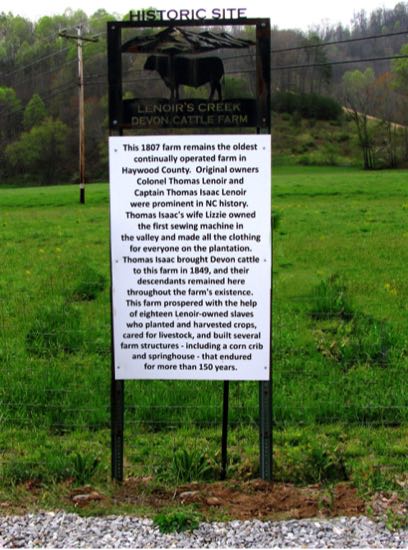Historic Signage
Bethel Community highways contain four signs that are a part of the North Carolina Highway Historical Markers Program. One of the oldest continuing programs of its type in the nation – since 1935 – the state program commemorates noteworthy people, places, and events that are of statewide significance.
Many people, places, and events that are of local importance are not eligible for the state signage program. To direct attention to notable local history, BRCO’s Historic Preservation Committee has developed its own marker project. To date, the organization has placed six local historic markers along roadsides in Bethel Community.
Other Commemorative Historic Markers
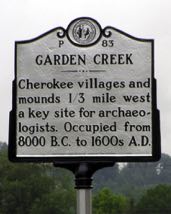
GARDEN CREEK ARCHAEOLOGICAL SITE:
Bethel’s earliest settlers came to the area 10,000 years ago in 8,000 B.C., according to the Garden Creek historical marker.
Four separate archaeological digs have involved investigation of the Garden Creek Native American settlement: 1880, 1915, 1965, and 2011.
The Garden Creek site is thought to encompass three Indian mounds and two villages on twelve acres.
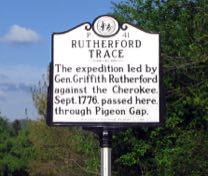
RUTHERFORD TRACE:
The Rutherford Trace march proceeded through Bethel and beyond in 1776 as part of the Revolutionary War effort. General Griffith Rutherford and his more than two thousand troops conducted a scorched earth progression against thirty-six Cherokee villages to eradicate Cherokee resistance to white settlement in the area. A state historic marker commemorates the historic trek on Highway #276 at Pigeon Gap across Waynesville Mountain.
INMAN CHAPEL:
The first Universalist Church west of Durham, Inman Chapel, was dedicated in 1902. Built by the Reverend James Anderson Inman, brother of Inman of "Cold Mountain" fame, the Bethel site earned a state historic marker for its first full-time female minister of a Universalist Church in the state who also started the first Universalist kindergarten: Hannah Jewett Powell.
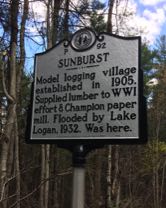
SUNBURST:
Sunburst Village, a logging community that existed in the first quarter of the 20th century in Bethel, was one of the largest logging operations in the region. The state historic marker near Lake Logan commemorates the contributions of raw material from Sunburst to the World War I effort.
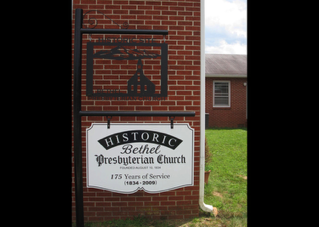
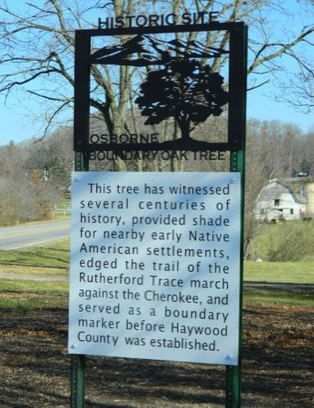
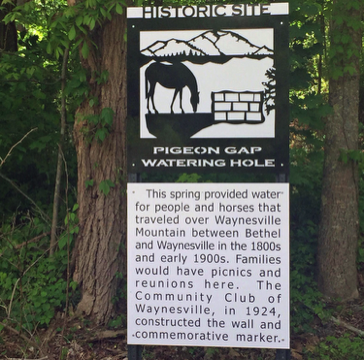
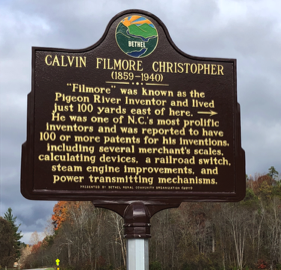
BETHEL PRESBYTERIAN CHURCH:
The Reverend Jesse Stalcup, Baptist minister and millwright, built the building in 1885 as the first Presbyterian Church in Haywood County. The church is Bethel Rural Community Organization’s home base. Floor to ceiling chestnut interior in the sanctuary provides a dramatic backdrop for learning about the history of Presbyterianism in Western North Carolina. Books 1 and 5 of "Legends, Tales & History of Cold Mountain" inform about the church’s unique past. See also "Walking in the Footsteps of Those Who Came Before Us" DVD and the Cold Mountain Heritage Driving Tour CD.
OSBORNE BOUNDRY OAK:
Oral history dates the tree to the Native American settlement era when a buffalo and Indian trail as well as a trading post, flanked the tree’s border. The tree’s first defined date is 1792 when it was massive enough to be used as a boundary marker for the Adlia Osborne land grant. The tree is designated as a "witness tree" by the Daughters of the American Revolution because the tree witnessed General Griffith Rutherford and his troops as they passed by the tree during the Rutherford Trace march against the Cherokee in 1776. The legendary scarlet oak has witnessed hundreds of years of history in Bethel Community and was saved from destruction in the 1970s when community citizens and organizations united to save the tree from widening of Highway #110. In 2010, under the supervision of BRCO, citizens and organizations assessed the tree’s health; BRCO hired arborists to doctor the aging tree with appropriate treatments in 2013, 2016 and 2021. BRCO placed its first local historic marker at the tree. For more information about the Osborne Boundary Oak’s history see "Legends, Tales & History of Cold Mountain", Book 6. See also "Walking in the Footsteps of Those Who Came Before Us" DVD and the "Cold Mountain Heritage Driving Tour" CD.
LENOIR'S CREEK FARM:
Descending from some of North Carolina’s most prominent citizens, the Lenoir family in Haywood County claimed ancestral ties to locations named for them: Avery County and the city/county of Lenoir. Thomas and Selina Louisa Avery Lenoir settled the land in 1806 and began a farm in 1807 that continues until today. Thomas was elected to the legislature and eventually amassed approximately 4,000 acres on the East Fork of the Pigeon River. The Lenoir’s slave-holding grew to 35. The family returned to Lenoir, but youngest son, Thomas Isaac Lenoir, returned to continue the farm and established a herd of Red Devon cattle by the mid-1850s. He married Mary Elizabeth Garrett, and they had three daughters and a son (died in infancy). During the Civil War Thomas Isaac was Captain of “the Highlanders," the NC 25th Infantry Regiment, Company F. To learn more about the Lenoir family and Lenoir’s Creek Farm see "Legends, Tales & History of Cold Mountain", Book 3. See also "Walking in the Footsteps of Those Who Came Before Us" DVD and the Cold Mountain Heritage Driving Tour CD.
PIGEON GAP WATERING HOLE:
Under the auspices of Bethel Rural Community Organization, Joey Rolland, Eagle Scout, restored a historic watering site atop Waynesville Mountain between Bethel and Waynesville that was once used as a rest stop for weary travelers and their animals, dating as far back as the early 1800s. Rolland cleared the site of overgrowth, uncovered the 1924 plaque placed by the Community Club of Waynesville, and erected a bridge. Bethel Rural Community Organization maintains the grounds, placed strategic directional signage, and erected a local historic marker at the site in 2016.
CALVIN FILMORE CHRISTOPHER
Since his death in 1940, civic minded people in Haywood County have desired to honor Calvin Filmore Christopher, Bethel resident who is generally considered to be one of North Carolina's most prolific inventors. BRCO members are finally able to recognize the man whose genius led him to introduce mechanical inventions that have changed the ease with which society functions. Reputed to have made over 100 inventions, Christopher's most noted development was the gasoline tank measureing device and the computimg scale. On NC Highway #110 near Max Thompson Road a marker, produced and funded by BRCO and individual members, pays homage to the almost forgotten inventor. Other information about Christopher is included in BRCO's Book 2 of "Legends, Tales and History of Cold Mountain."
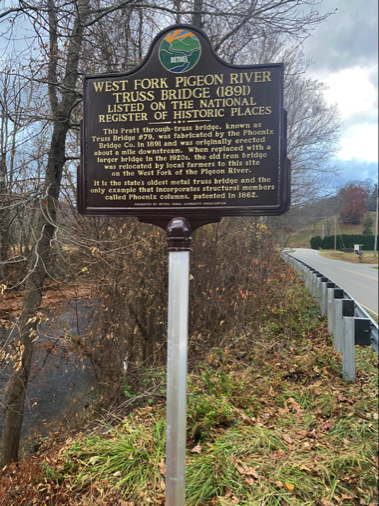
TRUSS BRIDGE #79
Haywood County Commissioners approved the Pratt Through Truss Bridge to be located over the Pigeon River near today’s intersection of Highway #110/#276. Dean and Westbrook Engineers of New York designed the bridge, and the Phoenix Bridge Company of Phoenixville, Pennsylvania, constructed it in 1891. Community men moved the bridge in the mid-1920s to its current location on Lake Logan Road. Truss Bridge #79 is NC’s oldest metal truss bridge and is the only truss bridge with decorative elements (starbursts and finials). The bridge’s Phoenix columns make it unique nationally. Carroll Jones wrote the successful National Register of Historic Places application that was approved in 2019.
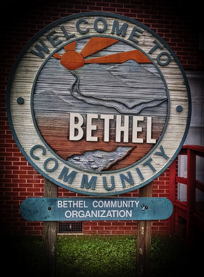
BETHEL RURAL COMMUNITY ORGANIZATION LOGO SIGN:
Bethel Rural Community Organization focuses on preserving the rich natural heritage of the community symbolized by the sunburst, mountains, valleys, streams, and river depicted on the sign.

PIGEON VALLEY QUILT BLOCK:
The Pigeon Valley Quilt Block focuses on names and associations connected with Bethel: Sunburst, Sonoma (Valley of the Moon), Passenger Pigeon, Pigeon Valley, Forks of Pigeon, Pigeon River, Bethel (House of God), Bethel Presbyterian Church, Cold Mountain and other local mountains that overlook local farms, barns, and agrarian lands. The Pigeon Valley Quilt block places BRCO on Haywood County’s Quilt Trail.
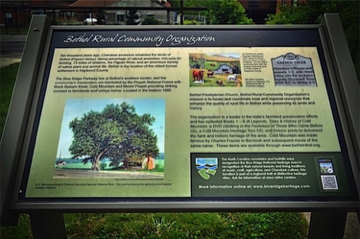
BLUE RIDGE NATIONAL HERITAGE AREA HERITAGE TRAIL MARKER:
BRCO is one of 3 in Haywood County and one of 70 sites in the region to earn a Blue Ridge National Heritage Area Heritage Trail marker to commemorate the community’s agriculture, Cherokee, and natural heritage.
